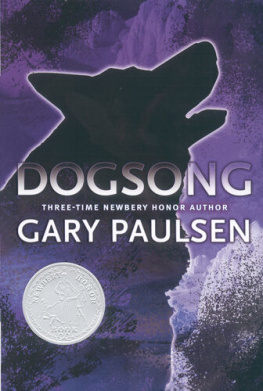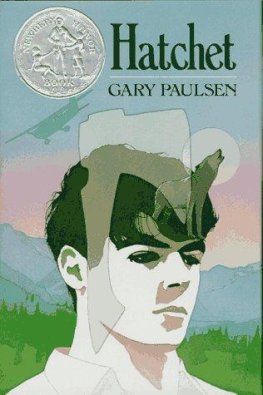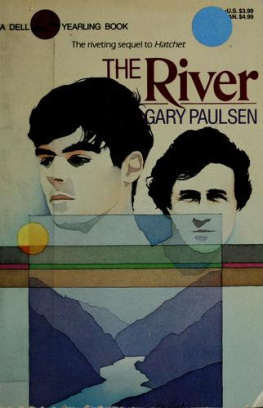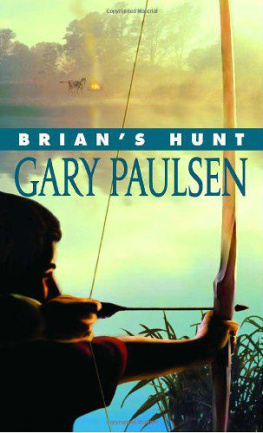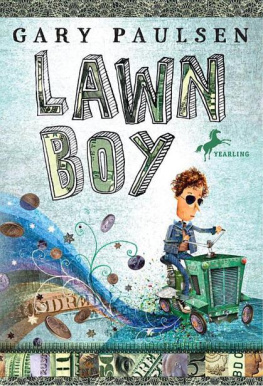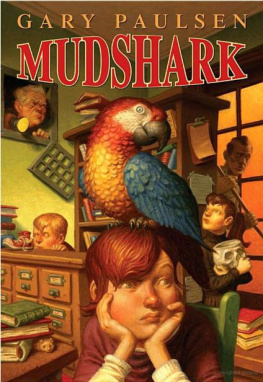ALSO BY GARY PAULSEN
Dancing Carl
Dogsong
Hatchet
Sentries
Shelf Life: Stories by the Book
Tracker
Woodsong
GARY PAULSEN is one of the most honored writers of contemporary literature for young readers, and the author of three Newbery Honor titles: Dogsong , Hatchet , and The Winter Room . He has written more than two hundred books for adults and young readers. He divides his time between New Mexico, Alaska, and on the Pacific.
SIMON & SCHUSTER BOOKS FOR YOUNG READERS
SIMON & SCHUSTER NEW YORK
Visit us at
simonandschuster.com/kids
authors.simonandschuster.com/Gary-Paulsen
INTERROGATUM: THREE THINGS TO LEARN
1. When a lawn mower goes over a lawn with tall dandelions in it and cuts them down, the stalks never grow back up above the height of the mower blade. How do they know it and how do they tell the plant to stay below this certain height, as if measured?
2. If an earthworm is placed in a glass tube with two forks and in one of the forks a wire with a tiny bit of electricity is placed so that if the worm goes up that fork and hits the electricity it will feel mild discomfort, then that worm will always go up the other fork. While they have small ganglia, earthworms have no real brain and probably no forms of communication other than chemical slime and so probably no real memory. If placed with another worm who has never been in the glass tube and then separated and the new worm is let go in a glass with two forks, the new worm will always take the safe fork, as if hed been told. How can this be?
3. It is said that the weight of all the ants on the planet far exceeds the weight of all humans on the planet and that in organization and numbers ants far exceed humans. They will, for instance, kidnap eggs from other ant mounds, hatch them out, raise them, and use them as slavesa level it was thought only humans had sunk to. Does all this not make ants the largest and most successful species on the planet?
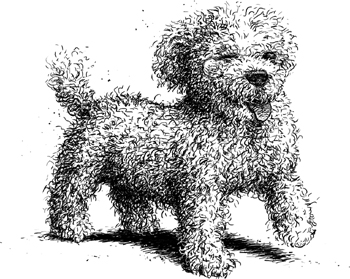
CHAPTER ONE
A Confusion of Horses, a Border Collie named Josh, a Grizzly Bear Who Liked Holes, and a Poodle with Three Teeth

First, a hugely diversionary trail:
Very few paths are completely direct, and this one seemed at first to be almost insanely devious.
The doctor diagnosed various problems, some lethal, all apparently debilitating, and left me taking various medications and endless rituals of check-ins and checkouts and tests and retests....
Which drove me almost directly away from the whole process. I moved first to Wyoming, a small town called Story, near Sheridan, where I kept staring at the beauty of the Bighorn Mountains, accessed by a trail out of Story, and at last succumbed to the idea of two horses, one for riding and one for packing.
The reasoning was this: I simply could not stand what I had becomestale, perhaps, or stalemated by what appeared to be my faltering body. Clearly I could not hike the Bighorns, or at least I thought I could not (hiking, in any case, was something I had come to dislikehatecourtesy of the army), and so to horses.
My experience with riding horses was most decidedly limited. As a child on farms in northern Minnesota, I had worked with workhorse teamsmowing and raking hay, cleaning barns with crude sleds and manure forksand in the summer we would sometimes ride these workhorses.
They were great, massive (weighing more than a ton), gentle animals and so huge that to get on their backs we either had to climb their legslike shinnying up a living, hair-covered treeor get them to stand near a board fence or the side of a hayrack (a wagon with tall wheels and a flatbed used for hauling hay from the field to the barn) so we could jump up and over onto their backs.
Once we were on their backs, with a frantic kicking of bare heels and amateur screaming of what we thought were correct-sounding obscenitiesmimicked from our eldersand goading, they could sometimes be persuaded to plod slowly across the pasture while we sat and pretended to be Gene Autry or Roy Rogerschildhood cowboy heroes who never shot to kill but always neatly shot the guns from the bad guys hands and never kissed the damsels but rode off into the sunset at the end of the story. We would ride down villains who robbed stagecoaches or in other ways threatened damsels in distress, whom we could save and, of course, never kiss, but ride off at the end of our imagination.
The horses werealwaysgentle and well behaved, and while they looked nothing like Champion or TriggerGenes and Roys wonderful, pampered, combed, and shampooed lightning steeds (Champ was a bay, a golden brown, as I remember it, and Trigger was a palomino, with a blond, flowing mane and tail)we were transformed into cowboys. With our crude, wood-carved six-guns and battered straw garden hats held on with pieces of twine, imagined with defined clarity that the pasture easily became the far Western range and every bush hid a marauding stage robber or a crafty rustler bent on stealing the poor rancher (my uncle, the farmer) blind.

Oh, it was not always so smooth. While they were wonderfully gentle and easy-minded, they had rules, and when those rules were broken, sometimes their retaliation was complete and devastating. On Saturday nights we went to the nearby towna series of wood-framed small buildings, all without running water or electricitywherein lived seventy or eighty people. There was a church there and a saloon, and in back of the saloon an added-on frame shack building with a tattered movie screen and a battery-operated small film projector. They showed the same Gene Autry film all the time, and in this film, Gene jumped out of the second story of a building onto the back of a waiting horse.
We, of course, had to try it, and I held the horseor tried towhile my friend jumped from the hayloft opening in the barn onto the horses waiting back.
He bounced oncehis groin virtually destroyedmade a sound like a broken water pump, slid down the horses leg, and was kicked in a flat trajectory straight to the rear through the slatted-board wall of the barn. He lived, though I still dont quite know how; his flying body literally knocked the boards from the wall.
I personally went the way of the Native Americans and made a bow of dried willow, with arrows of river cane sharpened to needlepoints and fletched crudely with tied-on chicken feathers plucked from the much-offended egg layers in the coop, which I used to hunt buffalo off the back of Old Jim.
Just exactly where it went wrong we werent sure, but Im fairly certain that nobody had ever shot an arrow from Old Jims back before. And Im absolutely positive that no one had shot said arrow so that the feathers brushed his ears on the way past.
The buffalo was a hummock of black dirt directly in front of Jim, and while I couldnt get him into a run, or even a trot, no matter what I tried, Im sure he was moving at a relatively fast walk when I drew my mighty willow bow and sent the cane shaft at the pile of dirt.
Just for the record, and no matter what my relatives might say, I did not hit the horse in the back of his head.
Instead the arrow went directly between Jims ears, so low the chicken feathers brushed the top of his head as they whistled past.
The effect was immediate and catastrophic. Old Jim somehow gave a mighty one-ton shrug so that all his enormous strength seemed to be focused on squirting me straight into the air like a pumpkin seed, and I fell, somersaulting in a shower of cane arrows and the bow, with a shattering scream on my part and hysterical laughter on the part of the boy with me.
Next page

